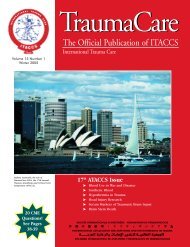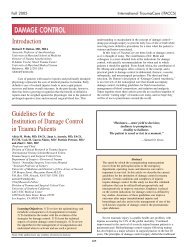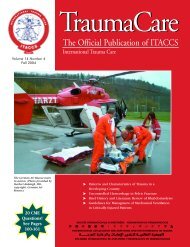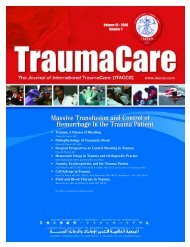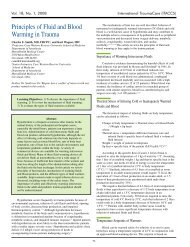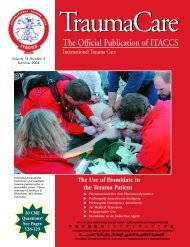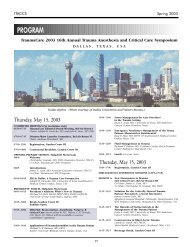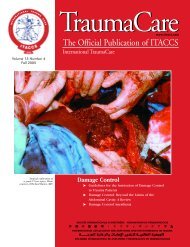The Official Publication of ITACCS - International Trauma ...
The Official Publication of ITACCS - International Trauma ...
The Official Publication of ITACCS - International Trauma ...
You also want an ePaper? Increase the reach of your titles
YUMPU automatically turns print PDFs into web optimized ePapers that Google loves.
<strong>ITACCS</strong> Spring 2003<br />
CME QUESTIONS<br />
This issue <strong>of</strong> <strong>Trauma</strong>Care can be used to earn 20 CME credit hours.<br />
Accreditation Statement<br />
This activity has been planned and produced in accordance with the Essential Areas and Policies <strong>of</strong> the Accreditation Council for Continuing Medical Education (ACCME) through the sponsorship<br />
<strong>of</strong> the <strong>International</strong> <strong>Trauma</strong> Anesthesia and Critical Care Society (<strong>ITACCS</strong>). <strong>ITACCS</strong> is accredited by the ACCME to sponsor continuing medical education (CME) for physicians and<br />
takes responsibility for the content, quality, and scientific integrity <strong>of</strong> this CME activity.<br />
Credit Designation Statement: <strong>ITACCS</strong> designates this educational activity for a maximum <strong>of</strong> 20 hours per issue in category 1 credit toward the<br />
AMA Physician’s Recognition Award.<br />
Nurse Anesthetists/CRNAs: Please apply to AANA for post-activity continuing education credits. Certificates <strong>of</strong> completion will be provided.<br />
Faculty Disclosure Statement<br />
It is the policy <strong>of</strong> <strong>ITACCS</strong> that faculty members disclose real or apparent conflict <strong>of</strong> interest relating to the topics <strong>of</strong> this educational activity and also disclose discussions <strong>of</strong> unlabeled/unapproved<br />
uses <strong>of</strong> drugs or devices in their presentations. <strong>The</strong> authors’ completed disclosure forms are on file in the managing editor’s <strong>of</strong>fice.<br />
INSTRUCTIONS<br />
• On the answer form at the bottom <strong>of</strong> page 71, circle only one response next to each number.<br />
• Complete the evaluation form.<br />
• Cut out or copy your completed answer form and evaluation form.<br />
• Write a check for $200 (or $100 accompanied by verification <strong>of</strong> current <strong>ITACCS</strong> membership), payable to the <strong>International</strong> <strong>Trauma</strong> Anesthesia and Critical Care Society.<br />
• Mail the forms and your check (and membership verification, if applicable) to <strong>ITACCS</strong>, Department <strong>of</strong> CME Credit, PO Box 4826, Baltimore, MD 21211.<br />
• <strong>The</strong> completed test will be accepted for grading if received by May 31, 2004.<br />
• Please allow 4 to 6 weeks for processing.<br />
CME QUESTIONS<br />
1. Which <strong>of</strong> the following therapies is appropriate for early resuscitation <strong>of</strong> the patient with active hemorrhagic shock?<br />
a. Pressor therapy with norepinephrine<br />
b. Rapid crystalloid administration to maintain SBP > 120<br />
c. Bicarbonate infusion to maintain pH > 7.30<br />
d. Administration <strong>of</strong> O-positive PRBC<br />
2. Dexmedetomidine is a potent respiratory depressant.<br />
a. True b. False<br />
3. Concerning traumatic thoracic aortic tears, which <strong>of</strong> the following statements is true?<br />
a. Paraplegia and death are less common after surgical repair in the presence <strong>of</strong> preoperative hemodynamic instability.<br />
b. Medical control <strong>of</strong> blood pressure with beta blockers (e.g., esmolol, metoprolol, labetalol) is <strong>of</strong> doubtful clinical importance.<br />
c. One-lung ventilation is contraindicated for descending thoracic aorta surgery because <strong>of</strong> the risk <strong>of</strong> hypoxemia.<br />
d. Delayed repair is <strong>of</strong>ten indicated in the presence <strong>of</strong> major co-morbidity (e.g, head injury, pulmonary contusion, coagulopathy).<br />
e. None <strong>of</strong> the above.<br />
4. <strong>The</strong> main goal <strong>of</strong> triage in a mass casualty setting in which health care resources are exceeded is to rapidly treat the most critically ill patients.<br />
a. True b. False<br />
5. Chemical warfare agents can act upon<br />
a. the central nervous system<br />
b. the alveoli<br />
c. the gastrointestinal system<br />
d. the bone marrow<br />
e. all <strong>of</strong> the above<br />
6. <strong>Trauma</strong> simulation is possible only in major centers with extensive resources.<br />
a. True b. False<br />
7. What is the unique contribution <strong>of</strong> the advanced patient simulators for trauma management training?<br />
a. Team training<br />
b. Acquiring technical skills<br />
c. Learning algorithms and protocols<br />
d. Diagnosis-making capability<br />
8. <strong>The</strong> difference between end-tidal and arterial carbon dioxide tension can be increased by:<br />
a. Pulmonary embolism.<br />
b. Is<strong>of</strong>lurane.<br />
c. Hypovolemia.<br />
d. Atropine.<br />
e. All <strong>of</strong> the above<br />
69




